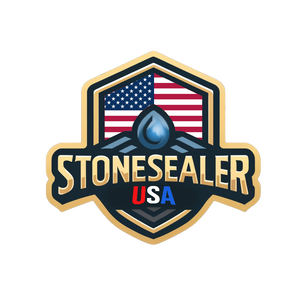The Homeowner’s Indoor Stone Sealing Handbook: The Complete Winter Protection Guide for Floors, Counters & Walls
The Homeowner’s Indoor Stone Sealing Handbook: The Complete Winter Protection Guide for Floors,
Counters & Walls
WINTER IS THE TRUE TEST OF INDOOR STONE — ARE YOUR SURFACES
READY?
If you own a home with natural stone floors, tile, a stone shower, or granite or marble countertops, you already know how beautiful they are… and how frustrating they can become when they start staining, darkening, or looking dull.
Here’s the part most homeowners don’t realize:
Stone doesn’t fail because it’s weak — it fails because it was never sealed properly… or hasn’t been resealed in years. And winter is when the damage really begins.
Cold weather brings:
- Wet boots
- Road salt
- Slush
- Mud
- Holiday cooking spills
- Hot pans
- Coffee and wine
- Higher indoor humidity
- Less ventilation for cleaning
- More traffic through your home
All of that gets absorbed into your stone if it isn’t sealed.
The good news? You can protect every one of your stone surfaces — and make them easier to clean all winter — with simple, safe, indoor-friendly sealing steps.
This guide will walk you through everything in clear, practical, homeowner-friendly language.
No
Contractor jargon.
No
complicated chemical talk.
Just what you need to know and how to do it the right
way.
DO YOUR INDOOR SURFACES ACTUALLY NEED SEALING?
(ALMOST ALWAYS YES.)
A surprising number of homeowners think stone comes “pre-sealed” or that sealing is optional.
It usually isn’t.
Stone is porous — even the hardest stone.
- Granite? Slightly porous.
- Marble? Quite porous.
- Travertine? Very porous.
- Slate? Extremely porous.
- Concrete? Absorbs almost anything.
- Porcelain tile? The tile is dense, but the grout is extremely porous.
- Quartzite? Usually needs sealing. -
- Soapstone? Depends on finish.
If any liquid can darken your stone or grout, it needs sealing.
The 15-Minute Test:
1. Put a tablespoon of water on the surface.
2. Leave it for 10–15 minutes.
3. Wipe away the water.
4. If the stone darkened → it absorbed the water → your stone, concrete, or tile is NOT protected.
5. If it stayed the same → you're okay for now.
WINTER’S BIGGEST ENEMIES FOR INDOOR STONE
Winter is brutal on stone surfaces for a few reasons homeowners overlook:
- Salt + melted ice = etching, staining, dull spots
- Holiday cooking is a stone sealer’s biggest stress test
- Showers get more use in winter
- Entryways take a beating
- Homes are closed up (less ventilation)
This is why winter is the perfect time for indoor-safe, low-odour, penetrating sealers.
CHOOSING THE RIGHT INDOOR STONE SEALER
Only certain sealers are:
- Safe for indoor winter use
- Low-odour
- Low-VOC
- Food-safe when cured
- Breathable
- Long-lasting
Two categories:
- Penetrating (Impregnating) Sealers Invisible protection, deep penetration, great for kitchens and floors.
- Enhancing Sealers Enriches colour, adds depth, ideal for slate, travertine, feature walls.
PRE-CLEANING: THE MOST IMPORTANT STEP
Pre-clean properly:
- Use a pH-neutral stone cleaner, like Stain-Proof Daily Floor Cleaner
- For grime: oxygen or alkaline cleaners, for best of both worlds use Stain-Proof Alkaline Cleaner
- For grout or textured floors: vacuum recovery equipment, or contact a trained pro: here
Avoid:
- Vinegar
- Bleach
- Caustic Degreasers
- Abrasives
DRYING TIME
Stone must be bone-dry before sealing.
Drying times:
- Countertops: ~12 hours
- Floors: 12–24 hours
- Showers: 24–48 hours
Use fans, dehumidifiers, open doors.
HOW TO APPLY PENETRATING SEALER
- Apply generously
- Let sit 5–15 minutes
- Wipe away ALL excess
- Apply a second coat if needed
- Allow proper cure time (4–24 hours)
RESEALING FREQUENCY
- Entryways: 5-10 years
- Kitchens: 10-15 years
- Bathrooms: 7-10 years
- Showers: 5-7 years
- Low-traffic areas: 10+ years
- Commercial Floors: 4-6 years
All of those timelines are when using the high quality sealers offered by StoneSealer Canada, other brands of sealers from big box stores or shady sealer dealers may make very long term claims but often need to be applied every year or two for proper performance.
WINTER TROUBLESHOOTING
- Water spots → etching → needs professional polishing
- Dark patches → oil → poultice
- Haze → grout not removed → Safe Acid Alternative
- White film → minerals → EffBOMB
- Grout dirty → needs sealing → needs maintenance plan
DIY OR HIRE A PRO?
DIY is good for:
- Counters
- Backsplashes
- Small floors
- Fireplace surrounds
Hire a pro for:
- Large floors
- Restoration
- Commercial jobs
- Specialty Stone
WINTER TIPS
- Use mats to wipe feet
- Clean spills fast
- Avoid harsh cleaners
- Reseal on time
- Don’t drag furniture
- Get an annual deep cleaning from a certified pro
- Test annually
A sealed stone surface is easier to clean, more resilient, and looks better all winter.
CONCLUSION
Indoor stone is a worthwhile investment, and winter is the toughest season for it.
But with proper sealing — done on schedule and professionally — your stone will stay beautiful, stain-free, and low-maintenance.
This guide walks homeowners through everything step-by-step so you can confidently protect your surfaces without needing specialized tools or a doctorate degree in geology and three days reading about every different sealer on the market.


